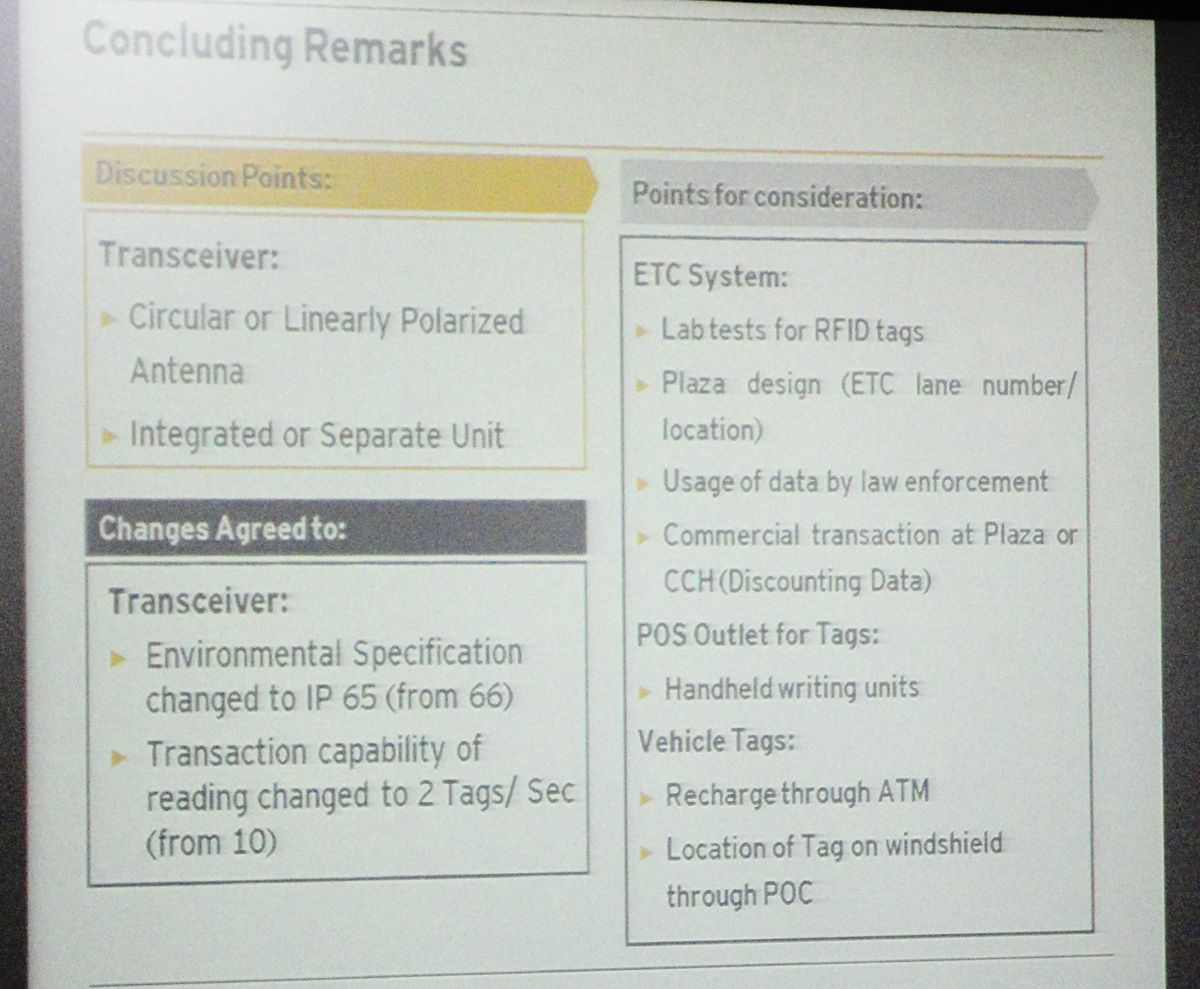Award in New South Wales, Australia
January 23, 2013

SICE has been awarded a specialist sub-contract package for the Operation and Management Control System (OMCS) to be delivered for the Tintenbar to Ewingsdale Pacific Highway upgrade. The $862 million project is jointly funded by the NSW State and Federal Governments and will provide approximately 17km of dual carriageway, starting at the northern end of the Ballina bypass at Ross Lane and extending to the Ewingsdale interchange. Construction started in September 2012 and is scheduled to be completed in 2014. The works also include two 434m double bore, dual carriageway tunnels.
Baulderstone, the construction company that was awarded a design and construct contract by RMS as the principal contractor for the works, has appointed SICE Pty Ltd as the preferred supplier for the OMCS after a competitive tendering process. The Scope of Works includes the design, supply, installation, system integration, testing and commissioning of an OMCS for the project, comprising the following subsystems:
- Traffic Management and Control System (TMCS)
- Plant Management and Control System (PMCS)
- Driver Advisory System
- Closed Circuit Television System
- Motorists’ Emergency Telephone System
- Radio Rebroadcasting System
- Communication Network
The equipment to be installed includes:
- Vehicle Detection based on loops
- Variable Message Signs
- Lane Usage Signs (cross/arrow signs)
- Variable Speed Limit Signs
- Tunnel Message Signs
- Boom gates for tunnel closures
- Moveable Medians
- OverHeight Detection
- Air quality system
- CCTV, both fixed and PTZ
- METS
- Radio rebroadcasting
- Communications network
- Control centre
The final solution will be fully integrated with RMS’s existing control centres at Grafton and Sydney, giving them full operational and monitoring capabilities.
This project, together with the recently awarded Waterview Project in Auckland (NZ), positions SICE as a top player in the freeway management, M&E and Tunnel Control sectors in Australasia, consolidating our long-term commitment with projects in Australia.
source: http://www.roadtraffic-technology.com
Workshop on Nationwide Electronic Toll Collection, held at Vigyan Bhawan, New Delhi on June 14, 2011
June 15, 2011
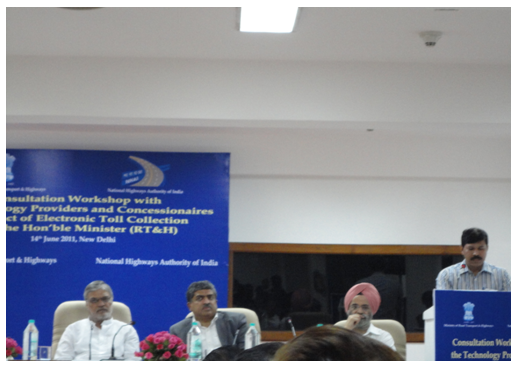
Workshop on Nationwide Electronic Toll Collection
- Mr. C P Joshi , Honrable Minister Road Transport and Highways
- Mr. Nandan Nilkani , Chairman , UIDAI
- Mr. R S GUJRAL , Chairman NHAI
- Mr. Ravi Palekar , GM (Electronics) , NHAI – Addressing the gathering
- Mr. Sachin Bhatia, CEO, Metro Infrasys
Workshop on Nationwide Electronic Toll Collection held at Vigyan Bhawan, New Delhi. With an objective of paving way for a unified Electronic Toll Collection (ETC) technology for National Highways in India, the Ministry of Road Transport & Highways constituted a Committee under the chairmanship of Shri Nandan Nilekani Chairman of UIDAI with a mandate to examine all technologies available for Electronic Toll Collection (ETC) and recommend the most suitable one for implementation throughout India. The other members of the Committee are Prof. Pankaj Jalote, Director, IIIT-Delhi ; Dr. Kolin Paul, Asst. Professor, IIT-Delhi ; Shri A.V. Sinha, DG (Road Development) & Special Secretary, MoRT&H and Shri. V.L. Patankar, Member (Technical), NHAI (Member Secretary).
The Union Minister for Road Transport & Highways Dr. C.P. Joshi has said that we should chalk out a plan to increase the percentage of national highways from present 2.2 % to 5 % in the next 10 years. Delivering inaugural address at the Consultation Workshop with the Technology Providers and Concessionaires in respect of Electronic Toll Collection (ETC) here today, he said that keeping in view the various types of highways there should be a hybrid pattern of toll collection. The Workshop was jointly organized by Ministry of Road Transport & Highways, National Highways Authority of India & National Informatics Centre. The Chairman of UIDAI Shri Nandan Nilkeni & Minister of State for RT&H Shri Tusharbhai A. Chaudhary also addressed the workshop. Shri R.S. Gujral, Secretary Ministry of Road Transport & Highways and Dr. V.K. Gairola, D.G (NIC) were present.
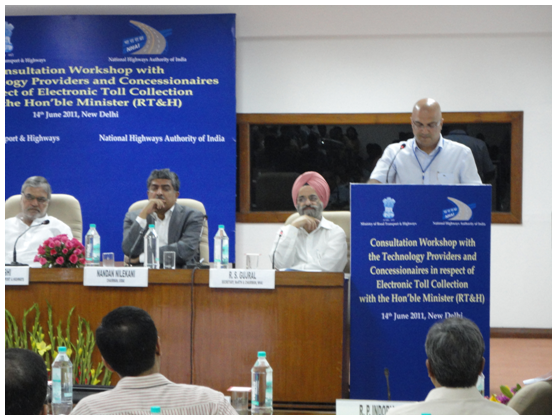
Mr. Sachin Bhatia CEO Metro Infrasys expressing the support from Industry Fraternity
Based on the recommendations of the committee headed by Mr. Nandan Nilekani to use RFID technology for ETC, the Apex Committee, responsible for ETC implementation planning, is in the process of prescribing certain standards which should be complied with all over the country to ensure interoperability. The primary purpose of this workshop was to take feedback from the key stakeholders, comprising concessionaires and ETC technology service providers. Security, cost effectiveness, convenience and scalability have been the main criteria based on which the detailing has been done.
Based on the feedback, the specifications and data detailing will be finalized for open market release. The plan is that the authorized manufacturers will be producing Transceivers and Tags based on these standards, the concessionaires will be procuring these Transceivers and in turn, the technology service providers will be integrating the entire ETC system at the toll plaza. Although details on other aspects like clearing house are being worked out simultaneously, majority of the decisions will depend upon these standards only.
Followings are the Tolling Companies, RFID Manufacturer and concessionaire took part in the workshop:
- Kapsch Metro
- Egis Infra
- L&T Infra
- GMR
- HCC Infrastructure
- JICA
- IRDSA
- DSC
- EFKON India
- Siemens
- IAITO Infotech Pvt. Ltd.
- ESSEN, Mumbai
- ATT System, Banglore
- Mitsubishi
- IBI Group
- Neology
- Steria
- Tag Factory
Brief of discussion over finalization of technology between committee and Industry Peoples:
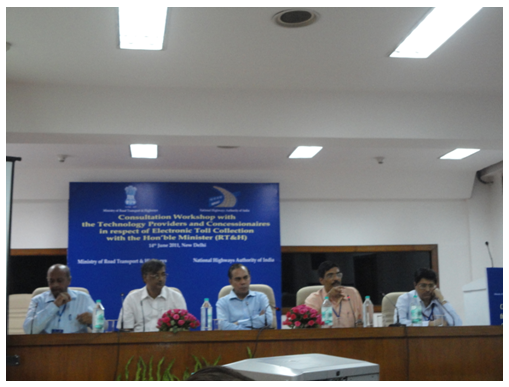
- Dr. B.K. Gairola, Director General, NIC – extreme left
- Dr. Y.K. Sharma, DDG, NIC - middle position
- Dr. Rajat Moona, Director General of CDAC, IIT Kanpur
- Dr. Y.K. Sharma, DDG, NIC - extreme Right
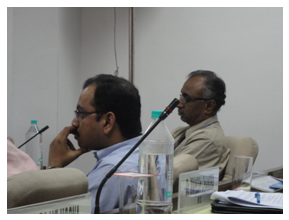 Mr. Venkat from GMR expressed change from IP 66 to IP 65 for the readers as IP 65 is also good enough and IP 66 will increase the cost for the readers without any additional value.
Mr. Venkat from GMR expressed change from IP 66 to IP 65 for the readers as IP 65 is also good enough and IP 66 will increase the cost for the readers without any additional value.
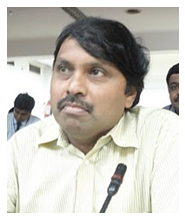 Mr. Hari from Efkon
Mr. Hari from Efkon
He raised an issue over the relative humidity of 100% for Transceiver antenna.
Committee Conclusion :
Committee agreed for the IP 65 standard and 95% relative humidity as it comply against all possible environmental threat at toll scenario.
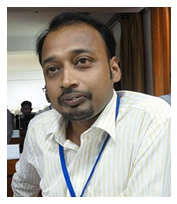 Mr. Anand Shenoy from IAITO Infotech Pvt. Ltd.
Mr. Anand Shenoy from IAITO Infotech Pvt. Ltd.
Raised his voice over minimum requirement of reading of 10 Tags per second with 240 bits of EPC memory and 64 bits of Tag Id.
Committee Conclusion: committee agreed onto change it to 2 Tags per second with above said minimum requirement. On the other query raised by Mr. Shenoy that the data retention period must be 3-4 year for the tag memory instead of 10 years as their is no UV protection asked for the tag and without any special material with the effect of UV rays its hard to maintain the data in tag for 10 years, The committee replied as they will keep it under consideration and if required they will bring it in next phase.
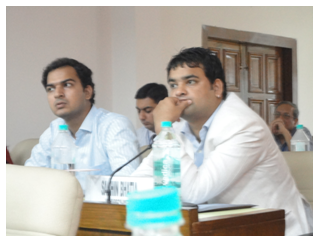 On the query raised by Team from Metro Infrasys- Mr. Nitin Thakur and Mr. Harimohan for the option of having color coded Tags for different class of vehicles, as it will help in operation at toll plazas. The Committee said that it is difficult to see the color in the moving car in the sun. However committee will discuss it in next phase.
On the query raised by Team from Metro Infrasys- Mr. Nitin Thakur and Mr. Harimohan for the option of having color coded Tags for different class of vehicles, as it will help in operation at toll plazas. The Committee said that it is difficult to see the color in the moving car in the sun. However committee will discuss it in next phase.
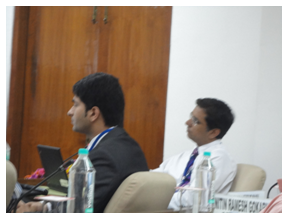 Mr. Vipul Sharma(Left), Mr. Mayank Manish(Right)
Mr. Vipul Sharma(Left), Mr. Mayank Manish(Right)
The long discussed topic was the polarization standard for the antenna, Panel has asked for circular polarization pattern for the antenna but Mr. Vipul Sharma and Mayank Manish from one of the leading manufacturer of RFID Equipment Neology reasoned to have it linearly polarized due to its long range and less interference phenomenon, also linearly polarized antennas can work at higher speed , committee keep this for discussion and will revert again.
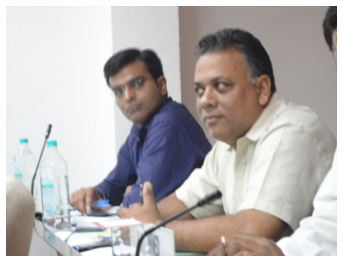 Mr. Manoj Agarwal and Mr. Manish from Delhi Gurgaon Expressway strongly supported the idea of a law for putting a penalty on cash vehicles coming to Tag lane .
Mr. Manoj Agarwal and Mr. Manish from Delhi Gurgaon Expressway strongly supported the idea of a law for putting a penalty on cash vehicles coming to Tag lane .
For the standard for the communication between plaza server and CCH server, there will be addition of Plaza id into the prescribed format by the committee. Plaza level fare plan and policy will be governed by the plaza itself while the global discount will be governed by the CCH server and will be updated in all the plaza server by CCH server itself. Committee also agreed to look into the various aspects of fare plans at different plazas.
Highlights of the Workshop:
ETC critical components:
Tag Distribution Channel & Inventory Management
- On-line channels by user
- Authorized service centers of vehicles (Service centre need to install the SPV client software and antenna connection), since centre must have authorized people to affix tags.
- RTO(Operation is similar to above)
- Vehicle dealer network(Operation is similar to above)
- Authorized point of sale installation(POS can be insurance companies, PUC centers, Petrol Pumps etc; Operation is similar to above)
Inventory Management of Tags:
SPV will keep track of allocated EPC Ids, Tag Ids etc. It will perform a demand forecast Tags and keep the tags available for distribution through distribution channel.
Handling Special Cases
- Valid ETC enabled vehicle was ejected due to non-read of Tag – Premium cash lane should verify it with the ETC database.
- Clone Tag – If customer complains/suspects that his/her Tag is cloned, Tag re-initiation is to be done for same Tag. Old Tag value is marked for special handling.
- Change in registration number of vehicle – Vehicle should approach distribution channel network and get a new tag. Old tag is to be destroyed physically and listed for special handling.
- De-registration of vehicle (due to destruction/ end of life/ Export etc.)-Tag is to be destroyed physically and listed for special handling.
Listing for Special Attention
Vehicle is listed for special attention following conditions:
- Insufficient balance as determined by clearing house
- Credit card co. declined the payment
- On Police look-out
- Suspected cloned Tag
- Tag with invalid Vehicle Registration no. (e.g. when Registration no. is changed)
- When toll plaza operator notices Tag carrying details different from vehicle itself (e.g. the vehicle Registration no. and/ or Vehicle class)
Videos
Conclusions drawn at the end of the seminar:
Documents Attached:
- Agenda Workshop
- Apex Committee for ETC Implementations – GOI, Draft Specifications Document
- ETC Report on RFID – July 2010
 This story is covered by Mr. Sachin Bhatia.
This story is covered by Mr. Sachin Bhatia.
Metro Infrasys Completes Madhucon’s Madurai Tuticorin Project for 24 Toll Lanes
March 17, 2011
Metro Infrasys, successfully completed M/s Madhcuon Project’s Madhurai Tuticorin Tollway and received the formal approval from the Independent consultant before the commercial operations date.
The Project comprises of 2 Toll Plazas with 12 lanes each and 4 sets of Weight in Motion systems. Mr. Srinivas Rao, Executive Director of Madhucon Projects limited congratulated Mr. Sachin Bhatia CEO of Metro Infrasys P Ltd for achieving the NHAI ‘s IC approval prior to the COD date so that the Commerical Operations could be started without any punchlist as regards the Tolling Solutions.
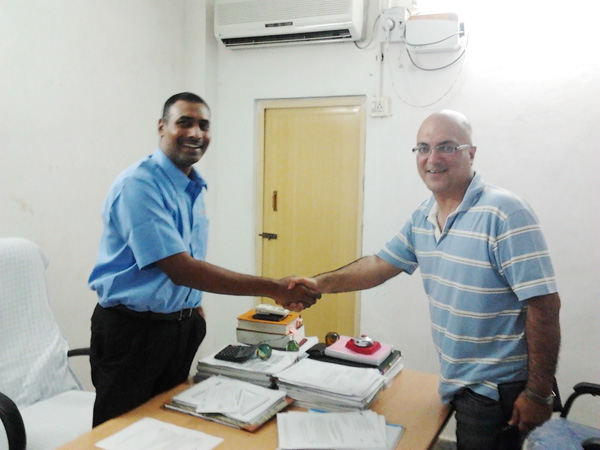
Based on the sucessful relationship, Metro has been awarded another project for Madhucon’s Assm project for Toll Plaza Electrification, a new division division started in Metro.
What does ITS stand for?
February 16, 2011
Please click the following link to know about ITS:
http://www.kapsch.net/en/ktc/Pages/what-is-ITS.aspx
Toll Roads in China: Speeding Up Growth
January 12, 2011
Infrastructure has played an instrumental role in the Chinese economy’s ascent to the position of a global economic powerhouse. And the overarching importance of infrastructure in China was underscored yet again when the sector grabbed a 38% lion’s share of the $586 billion Chinese stimulus package introduced in November 2008. Out of all the infrastructure sectors, the effort to improve the country’s roads has received the strongest impetus and investment from the Chinese government. According to consulting firm KPMG, since 2000 China’s expressway network has been growing on an average of 20% per year. With this, the country has zoomed to the second position globally in terms of expressway network, next only to the U.S.
Driving forces of road construction

Source: Infrastructure in China: Foundation for Growth, KPMG, 2009
Outlined in a series of five-year plans, the development of infrastructure in the Chinese economy has remained an integral part of its economic development initiatives, But expressway construction in China only gained momentum in 1989, when the forces of economic liberalization were gathering steam. As a result of these comprehensive economic reforms, the Chinese economy surged to an average annual growth rate of 9% in the three decades spanning 1978-2008, a remarkable achievement. Driven by industrial production and exports, this higher economic growth was naturally accompanied by a greater demand for freight transport, which in turn created a demand for construction of new roads. Higher living standards along with improved levels of domestic consumption further added to this transport demand. What’s more, China’s zooming car sales and its emergence as the largest car market globally in 2009, also necessitated the quick construction of highways and expressways. Notably, the building of highways is a crucial factor in the country’s “Go West” policy aimed for the integrated development of central and western China, which lags behind the more economically prosperous east, as well as some parts of the north1 .
National Trunk Highway System: Backbone of China’s road network

China’s ambitious National Trunk Highway System (NTHS), launched in 1990 originally envisaged 35,000 kilometers (21,748 miles) of expressways that would link all the major cities with each other as well as the ports. While this core of the Chinese transport system, covering a population of almost one billion, was due to be completed in 2020, it was functional by 2007, 13 years ahead of schedule. The NTHS, also known as the 7918 network, links all provincial capitals as well as cities with a population of more than 200,000, and incorporates the following:
- 7 Highways from Beijing
- 9 North to South vertical expressways
- 18 East to West horizontal expressways
Building expressways at a breakneck speed, China today boasts of 65,000 kilometers (40,389 miles) of expressway network, the second largest in the world, compared to a mere 147 kilometers (91.34 miles) in 1989 . The country is poised to expand this network further to 85,000 kilometers (52,817 miles) by 2020, according to the Ministry of Transport. For greater integration of rural areas in the economic development process, the government also plans to build and modernize about 270,000 kilometers (167,770 miles) of rural roads.
Regulatory framework for roads: Government at the helm
The fast-paced expansion of the road network in China, especially expressways, over the past 15 years has been possible due to the government’s systematic tiered approach. The development has been led by the State Council as a central entity for overall planning and standards, while the Provincial Transport Departments are responsible for detailed planning, design as well as building. Successive five-year plans have also outlined specific provincial targets for road construction, which have facilitated large-scale implementation simultaneously of many parallel projects.
The governance or regulatory framework for roads in China is as follows2 :
State Council: This is the highest executive organ of state administration, with the premier at the helm, along with ministers and state councilors. The State Council has the responsibility of approving and issuing plans and policies for road sector development.
Ministry of Transportation: The Ministry of Transportation (MOT) assumes the role of policy oversight as well as regulation of all transport modes, except railways.
Provincial Transport Departments & Transport Bureaus: The 27 Provincial Transport Departments and the transport bureaus for the four mega cities- Beijing, Chongqing, Shanghai and Tianjin- are responsible for the implementation of the transport programs and policies. They are also accountable for raising funds for the road projects, and for their operation as well as maintenance.
Financing of road projects
On the funding front, the provinces finance about 65%-90% of the capital cost needed to construct and maintain the expressways through their own budgets and debt. MOT sets policies, standards and provides investment support for construction. While expanding the inter-provincial National Trunk Highway System, the government decided to adopt a toll-based network, which would be predominantly financed by debt3 .
While the financing and management of the expressway network predominantly remains in the public sector domain, the government has adopted a distinctive form of Public-Private Partnership (PPP) financing for some expressway projects. For example, after completing the construction of a toll expressway, provincial governments set up an expressway corporation as a public limited company, listed on the stock exchange. The provincial government then invests the money paid by the shareholders into construction of new toll roads. As such, China followed a one road-one company model, which allows for joint venture, securitized ownership, direct private sector investment, as well as different forms of leasing and concessions. Overall, private investments constitute a mere 7% of expressway financing in China. Here, the build-operate-transfer (BOT) method of road construction and management, which is a popular form of PPP financing, has been recently introduced in China. It is a tendered process, in which the chosen concessionaire (private entity) finances, builds and operates a road for a specified period.

Source: ‘A Review of Institutional Arrangements for Road Asset Management: Lessons for the Developing World’, Cesar Queiroz and Henry Kerali, The World Bank, 2010.
China and India: Contrasting approach to road projects
In terms of the total road network, China ranks second, while India ranks third globally. A common characteristic of the road network in both countries is the predominance of rural roads, which constitute almost 90% of the total road length in China and 79% in India. While India boasts of a highway network of 66,590 kilometers (41,377 miles), its minuscule expressway network of 200 kilometers (124.3 miles) is dwarfed by China’s 65,000 kilometers (40,389 miles) expressway network4 .
While traditionally road construction in India was entirely undertaken and financed by the government, budgetary constraints have resulted in alternative models for road projects. With the objective of attracting private investment in road development, maintenance and operation, the National Highways Act (NH Act) of 1956 was amended in June 1995. These amendments facilitated private entities to invest in the NH projects, as well as levy, collect and retain fee from users, and regulate traffic on these highways as per the provisions of the Motor Vehicle Act of 1988.
The National Highways Development Program (NHDP) forms the backbone of India’s road network with a length of 66,590 kilometers (41,377 miles). While this constitutes only 2% of India’s total road network it, it carries about 40% of the total road traffic. Launched in 2001, the NHDP is spread over seven phases to be completed by 2015. This ambitious program consists of connecting the four metropolitan cities of New Delhi, Mumbai, Chennai and Kolkata (the Golden Quadrilateral), while substantially upgrading its existing network too.
Read full article here:
http://www.thomaswhite.com/explore-the-world/BRIC-spotlight/2010/china-toll-roads-expressways.aspx
Toll on two-lane roads to drive costs down
June 30, 2009
More than 10,000 kms of roads may get tolled across the country. In what may be called a first, the ministry of road transport and highways is considering a proposal to toll two-lane roads. This is being done to not only recover the cost of construction but also ensure funds for their maintenance and upkeep. According to a senior government official, the move has come as a part of the government’s attempt to attract more road developers and also reduce the burden on annuity and build operate transfer (BOT) projects.
So far two-lane roads are not tolled across the country. But the idea is being considered especially because the government may award the construction of two-lane national highways on certain lean traffic areas across the country. This is being done to reduce the cost at a time when developers have been shortage of funds, as the official said.
The move will require making changes to the toll policy of the government, which provides for tolling of four and six lane highways currently. The ministry had introduced a new toll policy in December 2008 by the way of which toll rates had been doubled or trebled on certain stretches.
The current toll policy stipulates a fee of Rs 0.65 per kilometre for cars jeeps etc, Rs 1.05 per km for light commercial vehicles, Rs 2.20 for buses and trucks, Rs 3.45 for heavy construction machinery and Rs 4.20 for vehicles with over seven axles. However, these are the recommended rates for four and six lane highways and a similar schema would have to be prepared for two lane highways, if the proposal gets implemented.
The fee for two-lane highways is expected to be much lower but the location will also matter in determining it. For instance, it may be higher for hilly terrain roads.
The government has been working on a plan to re-engineer roads and thereby reduce their cost. The National Highways Authority of India (NHAI) is considering the removal of a number of additional structures on highways that escalate the cost. Taking this further, the minister for roads recently suggested that even in areas where two lane roads are being considered tolling should be implemented.
However, there is a flip side two lanes as well. They are less safe than four or six lane highways as there is no divider to prevent head on collisions. Even though we support the idea, the viability of tolling two lane highways would have to be considered in the light of the administrative cost of collection, a road expert from the National Highways Builders Federation (NHBF) said.
Currently there is a network of over 70,000 kms of national highways in the country, the maintenance of which comes under the central government. Even though national highways are only 2 per cent of the total road network, they carry bulk of the country’s traffic at over 65 per cent.
Source:indianexpress.com
Kapsch TrafficCom AG is awarded two prizes
June 22, 2009
Press Release
Kapsch TrafficCom AG is awarded two prizes: important award for innovative traffic telematics solution in the USA and the Stock Exchange Prize in Austria
![]() Kapsch TrafficCom AG was recently awarded by the well-known US traffic organisation, ITS merica for an innovative traffic telematics solution. ITS America awarded the “5.9 GHz Dedicated hort Range Communications (DSRC) Smart Road Technologies for Traffic Safety and Mobility” by Kapsch with the “Best Innovative Practice” prize. Specifically, the prize was awarded for the innovative Kapsch implementation of forty 5.9 GHz DSRC toll portals in New York City and New York State. Kapsch TrafficCom has been active in the USA since 2008. The ITS America award once again underscores the leading position of Kapsch TrafficCom as an internationally active vendor of innovative traffic telematics solutions.
Kapsch TrafficCom AG was recently awarded by the well-known US traffic organisation, ITS merica for an innovative traffic telematics solution. ITS America awarded the “5.9 GHz Dedicated hort Range Communications (DSRC) Smart Road Technologies for Traffic Safety and Mobility” by Kapsch with the “Best Innovative Practice” prize. Specifically, the prize was awarded for the innovative Kapsch implementation of forty 5.9 GHz DSRC toll portals in New York City and New York State. Kapsch TrafficCom has been active in the USA since 2008. The ITS America award once again underscores the leading position of Kapsch TrafficCom as an internationally active vendor of innovative traffic telematics solutions.
“The ITS Award is the most important prize of its type – only this programme honours the most innovative, efficient and influential achievements in the industry worldwide”, explains Erwin Toplak, Management Board Member of Kapsch TrafficCom AG. “We are pleased that this coveted award honours our performance in the field of 5.9 GHz DSRC networks for improving the safety, reliability and
infrastructure of US roads”.
Kapsch TrafficCom has been active in the USA since 2008. In the previous year, the company completed the testing of a 5.9 GHz DSRC telematics test station in the vicinity of Denver, Colorado, with impressive success. Kapsch TrafficCom received the latest award for its innovative implementation of forty 5.9 GHz DSRC telematics stations in New York City and New York State in a demonstration installation. These telematics stations communicate with on-board units, which are located in the vehicles and contribute to improving traffic safety, mobility and environmental compatibility. The architecture used enables the operation of more than 20 applications from the fields of safety, mobility, toll payment and toll information. The 5.9 GHz DSRC system from Kapsch TrafficCom was introduced at the ITS America Annual General Meeting 2009, which was held from 1 – 3 June 2009 at the Gaylord National Convention Center.
“With 5.9 GHz DSRC, intelligent transport solutions achieve a new technological dimension that significantly increases the benefit for the user”, says Scott Belcher, President of ITS America. “Kapsch is the driving force when it comes to launching high-performance 5.9 GHz DSRC applications for safety, mobility and payment infrastructure on the global markets. As traffic services in the USA are continuously gaining in importance, we expect improved transport infrastructure to provide the market with more safety, among other things”.
At about the same time, Kapsch TrafficCom achieved second place in the Small and Mid Cap Prize category of the Vienna Stock Exchange Prize. This prize evaluates companies that are listed on the ATX Prime Index and distinguish themselves particularly positively with regard to criteria such as reporting, investor relations and technical market factors.
Kapsch TrafficCom is an international provider of innovative traffic telematics systems. Kapsch TrafficCom develops and supplies mainly electronic toll systems (Electronic Toll Collection – ETC), especially Multi-Lane Free-Flow (MLFF) ETC systems, and offers the technical and commercial operation of these systems. In addition, Kapsch TrafficCom offers traffic management solutions that focus on traffic safety and traffic influencing, electronic access control systems and parking space management. With more than 220 customer references worldwide in 36 countries on all five continents, with a total of more than fourteen million OBUs and nearly 12,000 equipped road lanes, Kapsch TrafficCom has positioned itself among the global market leaders of ETC systems. Kapsch TrafficCom has its headquarters in Vienna, Austria, and has subsidiaries and representative offices in 22 countries.
Vienna, 19th June 2009
For further information:
Brigitte Herdlicka
Public Relations & Sponsoring
Kapsch Group
Phone: +43 (0) 50 811 1710
1120 Vienna, Am Europlatz 2
E-Mail: [email protected]
www.kapschtraffic.com
www.kapsch.net
Comments on Experiences of use of Tunnels for Tolling from the Tolling Fraternity
November 14, 2008
Dear Members of the Tolling Fraternity,
One of our client is building a toll plaza with 12 toll lanes ; and would like to have the comments of different TOll Operators on the experience of using Tunnel as below:
1. Is the investment of a Tunnel Justified for a Toll Plaza with 12 lanes ?
2. What are the experiences of similar projects which have worked without a tunnel.
I request the different concessionaires to share thier expereince on this on the Indian tollways Forum.
Looking forward to the receiveing the responce from the distinguished members of the Tolling and Concessionaires Community
BR,
Sachin Bhatia
CEO ,
Metro Road Systems P Ltd
A Leading Road Operation and Engineering Consulting Company Requires “HTMS/Toll Expert” for NHAI IC Projects
October 10, 2008
We are in search for the position of “HTMS/Toll Expert” for NHAI IC Projects.
Requirement for the above position is:
The candidate should be a senior Systems Engineer having experience of at least 15 Years.
He should be an expert in preparation of standards for projects of toll collection and HTMS. He should have bachelors degree in Civil Engineering/Electronics/Computer Science/other relevant areas. He should have experience of international latest practices in the field of HTMS and tolling. He should have work experience on at least 2 similar projects in similar capacity.
Please send us the CVs as early as possible.
Kapsch TrafficCom delivers Toll Systems for Urban Motorways in Bangkok
September 4, 2008
Kapsch TrafficCom impresses yet again with a new project in Asia: The company is constructing modern toll systems for three of the largest motorways in Bangkok. Kapsch TrafficCom Sweden will be working with two Thai companies under the joint venture FKS. The order for more than 55 kilometres of motorway in total will be completed in August 2009. Its worth is estimated at 8.5 million euros.
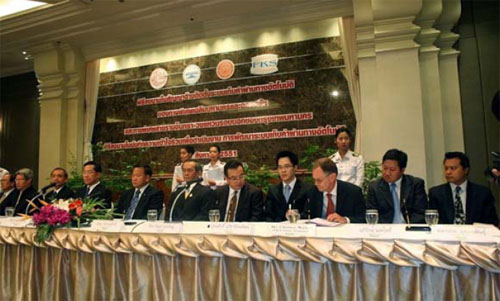
(Signing of contract – Christer Weiner, Kapsch TrafficCom Sweden, together with the Thai partners and customers)
As from autumn 2009, visitors to Bangkok will be escorted on their journey into the centre of the city by Austrian toll equipment. For Kapsch TrafficCom was able to notch up an order recently to fit out three large motorways in Bangkok. More specifically, the company will install the system by order of the Expressway & Rapid Transit Authority of Thailand (EXAT), in cooperation with the two Thai companies Fatima Group and Smart Traffic Co Ltd – as FKS Joint Venture. The Chalerm Maha Nakhon Expressway (consisting of three sections with a total length of 27.1 kilometres), the Chalong Rat Expressway (six-lane with a length of 18.7 km) and the Ramindra Outer Ring Project (with a total length of 9.5 kilometres) are set to be equipped with toll systems.
“Kapsch TrafficCom has repeatedly been successful in Asia. By replacing the 8-year old equipment and upgrading the electronic toll system, the flow of traffic on these three motorways will be sped up and traffic jams will to a large extent be avoided. This was possible primarily because of the extensive expertise of our employees and due to our many years of experience on the Asian market”, declares Erwin Toplak, Member of the Board, Kapsch TrafficCom AG.
The contract to set up the largest electronic toll system to date and a central system for registering and guiding traffic comprises altogether 80 lanes. The new infrastructure will include 100,000 CEN DSRC compatible transponders, 100,000 non-contact smart cards and other equipment (i.a. server equipment, a network and a CCTV video camera system). The system will be completed in autumn 2009 and comprises an order volume of approximately 8.5 million euros.
Kapsch TrafficCom is an international supplier of innovative road traffic telematics solutions. Its principle business is the development and supply of electronic toll collection (ETC) systems, in particular for the multi-lane free-flow (MLFF) of the traffic, and the technical and commercial operation of such systems. Kapsch TrafficCom also supplies traffic management systems, with a focus on road safety and traffic control, and electronic access systems and parking management. With more than 140 reference projects in 30 countries in Europe, Australia, Latin America, in the Asian/Pacific region and in South Africa, and with almost 12 million on-board units (OBUs) and nearly 11,000 equipped lanes, Kapsch TrafficCom has positioned itself among the leading suppliers of ETC systems worldwide. Kapsch TrafficCom is headquartered in Vienna, Austria, and has subsidiaries and representative offices in 20 countries.
For further information:
Brigitte Herdlicka
Public Relations & Sponsoring
Kapsch Group
Phone: +43 (0) 50 811 1705
A-1120 Vienna, Wagenseilgasse 1
E-mail: [email protected]
www.kapschtraffic.com
www.kapsch.net
